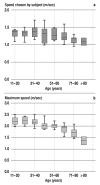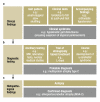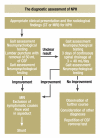Gait disturbances in old age: classification, diagnosis, and treatment from a neurological perspective
- PMID: 20490346
- PMCID: PMC2872829
- DOI: 10.3238/arztebl.2010.0306
Gait disturbances in old age: classification, diagnosis, and treatment from a neurological perspective
Abstract
Background: Gait disturbances are among the more common symptoms in the elderly. Reduced mobility markedly impairs quality of life, and the associated falls increase morbidity and mortality.
Methods: Review of the literature based on a selective search (PubMed) on the terms "gait," "gait disorder," "locomotion," "elderly," "geriatric" and "ageing" (2000-11/2009) and the findings of the authors' own studies on gait changes in old age and on the functional brain imaging of gait control.
Results: Gait disturbances in the elderly are often of multifactorial origin. The relevant pathogenetic factors include sensory deficits (visual, vestibular, somatosensory), neurodegenerative processes (cortical, extrapyramidal motor, cerebellar), toxic factors (medications, alcohol), and anxiety (primary or concerning falls). A clinically oriented classification of gait disorders is proposed, which, on the basis of the characterization of gait and the accompanying clinical findings, enables identification of the etiological factors and points the way to rational therapy. Current research topics in the study of gait disturbances are also discussed, including quantitative gait analysis, interactions between locomotion and cognition (dual tasking), and functional imaging approaches.
Conclusions: The evaluation of elderly patients whose chief complaint is a gait disturbance should be directed toward the identification of specific deficits. This is the prerequisite for rational therapy, even when the problem is of multifactorial origin. The preservation of mobility is important in itself, and also because the ability to walk is closely correlated with cognitive performance.
Figures





Comment in
-
Hyponatremia.Dtsch Arztebl Int. 2010 Oct;107(40):709; author reply 710. doi: 10.3238/arztebl.2010.0709a. Epub 2010 Oct 8. Dtsch Arztebl Int. 2010. PMID: 21031130 Free PMC article. No abstract available.
-
Impaired visual function.Dtsch Arztebl Int. 2010 Oct;107(40):709-10; author reply 710. doi: 10.3238/arztebl.2010.0709b. Epub 2010 Oct 8. Dtsch Arztebl Int. 2010. PMID: 21031131 Free PMC article. No abstract available.
Similar articles
-
[Gait disorders in the elderly: prospects for a symptomatic therapy].Fortschr Neurol Psychiatr. 2012 May;80(5):260-6. doi: 10.1055/s-0031-1299428. Epub 2012 May 7. Fortschr Neurol Psychiatr. 2012. PMID: 22566138 Review. German.
-
Impaired visual function.Dtsch Arztebl Int. 2010 Oct;107(40):709-10; author reply 710. doi: 10.3238/arztebl.2010.0709b. Epub 2010 Oct 8. Dtsch Arztebl Int. 2010. PMID: 21031131 Free PMC article. No abstract available.
-
Hyponatremia.Dtsch Arztebl Int. 2010 Oct;107(40):709; author reply 710. doi: 10.3238/arztebl.2010.0709a. Epub 2010 Oct 8. Dtsch Arztebl Int. 2010. PMID: 21031130 Free PMC article. No abstract available.
-
Neurological gait disorders in elderly people: clinical approach and classification.Lancet Neurol. 2007 Jan;6(1):63-74. doi: 10.1016/S1474-4422(06)70678-0. Lancet Neurol. 2007. PMID: 17166803 Review.
-
[Gait disorders in geriatric patients. Classification and therapy].Nervenarzt. 2015 Apr;86(4):431-9. doi: 10.1007/s00115-014-4182-8. Nervenarzt. 2015. PMID: 25801948 Review. German.
Cited by
-
Mobile Spatiotemporal Gait Segmentation Using an Ear-Worn Motion Sensor and Deep Learning.Sensors (Basel). 2024 Oct 4;24(19):6442. doi: 10.3390/s24196442. Sensors (Basel). 2024. PMID: 39409482 Free PMC article.
-
Clinical and MRI features of gait and balance disorders in neurodegenerative diseases.J Neurol. 2023 Mar;270(3):1798-1807. doi: 10.1007/s00415-022-11544-7. Epub 2022 Dec 28. J Neurol. 2023. PMID: 36577818 Review.
-
Clinical Whole-Body Gait Characterization Using a Single RGB-D Sensor.Sensors (Basel). 2025 Jan 8;25(2):333. doi: 10.3390/s25020333. Sensors (Basel). 2025. PMID: 39860703 Free PMC article.
-
Balance and gait in older electroconvulsive therapy recipients: a pilot study.Neuropsychiatr Dis Treat. 2013;9:805-12. doi: 10.2147/NDT.S42628. Epub 2013 Jun 5. Neuropsychiatr Dis Treat. 2013. PMID: 23766650 Free PMC article.
-
Machine Learning Based Abnormal Gait Classification with IMU Considering Joint Impairment.Sensors (Basel). 2024 Aug 28;24(17):5571. doi: 10.3390/s24175571. Sensors (Basel). 2024. PMID: 39275482 Free PMC article.
References
-
- Stolze H, Klebe S, Baecker C, et al. Prevalence of gait disorders in hospitalized neurological patients. Mov Disord. 2005;20:89–94. - PubMed
-
- Sudarsky L. Gait disorders: prevalence, morbidity, and etiology. Adv Neurol. 2001;87:111–117. - PubMed
-
- Stolze H, Klebe S, Zechlin C, Baecker C, Friege L, Deuschl G. Falls in frequent neurological diseases - prevalence, risk factors and aetiology. J Neurol. 2004;251:79–84. - PubMed
-
- Alexander NB. Definition and epidemiology of falls and gait disorders. In: Sirven JI, Malamut BL, editors. Clinical neurology of the older adult. Philadelphia: Lippincott Williams & Wilkins; 2002. pp. 108–116.
Publication types
MeSH terms
LinkOut - more resources
Full Text Sources
Medical

